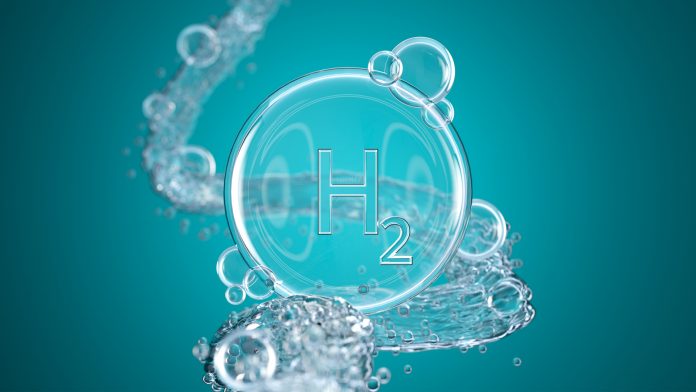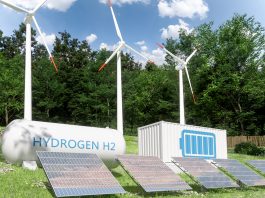Researchers discover that nickel-cobalt metal dimer on nitrogen-doped carbon can catalyse electrolysis under both acidic and alkaline conditions.
The increasingly foreboding threats of climate change, companied with the limited reservoir of fossil fuels, has made it necessary for scientists to develop alternative technologies to produce more sustainable fuel alternatives. Green hydrogen generated from the electrolysis of water using renewable electricity, is believed to be a next-generation renewable energy source for the future. However, the majority of hydrogen fuel is obtained from the refining of fossils fuels due to the high cost of electrolysis.
The efficiency of water electrolysis is currently limited and often requires high cell voltage due to the lack of efficient electrocatalysts for hydrogen evolution reactions. Noble metals such as platinum (Pt) are employed as catalysts to improve hydrogen generation in both acidic and alkaline media. Nevertheless, these noble metal catalysts are incredibly expensive and exhibit poor stability under long-term operation. Single-atom catalysts have recently presented excellent activity when compared to their nanomaterial-based equivalents. This is due to their ability to achieve 100% atom utilisation, whereas in nanoparticles, only the surface atoms are available for reaction. Nevertheless, due to the simplicity of the single-metal-atom centre, preforming further modifications of the catalysts to undertake complex multi-step reactions becomes complicated.
Single-atom dimers
The easiest way to alter and modify the single atoms is by transforming them into single-atom dimers, which is a combination of two different single atoms brought together. Turning the active site of single atom catalysts with dimers can improve the reaction kinetics due to the synergistic effect between two different atoms. Yet, while the synthesis and identification of the single-atom dimer structure have been understood conceptually, its practical realisation has proven difficult.
This issue has been tackled by a research team at the Centre for Integrated Nanostructure Physics within the Institute for Basic Science (IBS), located in Sungkyunkwan University and lead by Associate Director Lee Hyoyoung. The IBS research team have successfully established an automatically dispersed Ni-Co dimer structure stabilised on a nitrogen-doped carbon support, which they named NiCo-SAD-NC.
“We synthesised Ni-Co single atom dimer structure on nitrogen (N)-doped carbon support via in-situ trapping of Ni/Co ions into the polydopamine sphere, followed by pyrolysis with precisely controlled N-coordination,” explained Ashwani Kumar, the first author of the study. “We employed state-of-the-art transmission electron microscopy and x-ray absorption spectroscopy to successfully identify these NiCo-SAD sites with atomic precision.”
Optimal dimer structure conditions research
These researchers discovered that annealing for two hours at 800°C within an argon atmosphere was the optimal condition for obtaining the dimer structure. Other alternative atom dimers, such as CoMn and CoFe could also be synthesised utilising the same method, proving the universality of their strategy. They also evaluated the catalytic efficiency of this new system regarding the overpotential required to drive the hydrogen evolution reaction. The NiCo-SAD-NC electrocatalyst has a comparable level of overvoltage as commercial Pt-based catalysts in acidic and alkaline media. NiCo-Sad-NC also went on to preform eight times higher activity levels than NI/Co single-atom catalysts and heterogeneous NiCo nanoparticles in alkaline media. Simultaneously, it achieved 17- and 11-times higher activity than Co and Ni single-atom catalysts, and 13 times higher than the conventional Ni/Co nanoparticles in acidic media.
Additionally, the researchers also exhibited the long-term stability of the new catalyst, which was able to drive reaction for 50 hours without any structural change. The NiCo-SAD exhibited superior water dissociation and optimal proton absorption, when compared to other single-atom dimers and Ni/Co single-atom sites, enhancing the activity of PH-universal catalysts established on the density functional theory simulation.
“We were very excited to discover that the novel NiCo-SAD structure dissociates water molecules with a much lower energy barrier and accelerates hydrogen evolution reaction in both alkaline and acidic media with performances comparable to that of Pt,” said the corresponding author of the study, Associate Director Lee Hyoyoung. “This addressed the shortcomings of the individual Ni and Co single-atom catalysts. The synthesis of such single atom dimer structure was a long-standing challenge in the field of single-atom catalysts.” He added, “this study takes us a step closer to a carbon-free and green hydrogen economy. This highly efficient and inexpensive hydrogen generation electrocatalyst will help us overcome long-term challenges of cost-competitive green hydrogen production: to produce high-purity hydrogen for commercial applications at a low price and in an eco-friendly manner.”
This study was published in Nature Communications (IF 14.92), a world-renowned journal in the field of basic science.









